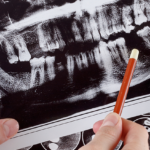The Guide to Dental Implants: Everything You Need to Know
Exploring Types, Benefits, and Costs of Dental Implants, Including All-on-4 and Snap-On Dentures
This page provides a comprehensive overview of dental implants, exploring what they are, their advantages, an estimate of costs, and much more. To delve deeper into the variety of implant options, such as All-on-4s, implant-supported fixed bridges, and snap-on dentures, please read this blog post: All-on-4’s Permanent Bridges and Snap-on’s. Visit the All-on-4 Procedure page if you are considering complete mouth restoration.
What is the Structure and Parts of a Dental Implant?

The Building Blocks of a Beautiful Smile: The Intricate Components of Dental Implants, Crafted to Perfection for Seamless Integration and Lasting Dental Restoration.
A dental implant is a cylindrical post-inserted into the jawbone at the gum line that replaces the root of missing teeth and serves as the base for a replacement tooth. The procedure allows the replacement of natural teeth with a crown or bridge. Using an artificial material such as titanium, the dental implant can bond to the bone below the gum line and form a site for a dental substitute to be attached. It typically takes four to six months for a dental implant to bond to the bone, and only then can the restoration tooth be attached. Once the dental implant is placed, the body naturally tends to “osseointegrate” or accept and bond the dental implant to the bone in preparation for a dental crown, a bridge, or a denture.
A small connector called an abutment is placed on the dental implant to facilitate the attachment of replacement teeth once healing and bonding are complete. The abutment is attached to the dental implant and serves as the base for the prosthetic dental component, which is then either cemented or screwed in for its final placement. To make the new tooth (or teeth), the dentist takes impressions of our natural teeth and then uses that to determine the shape and placement of the replacement tooth.
What are the Benefits of a Dental Implant?
Dental implants can be for a single tooth or multiple teeth or as a structure to attach dentures. Dental Implants can improve appearance, help speech, increase comfort, help chewing and digestion, and improve overall oral health. Dental implants are more durable. While natural teeth are susceptible to decay, leading to root canals and other dental interventions, dental implants are metal and do not decay or need root canals. The dental implant procedure usually takes two or three visits.
In some areas in the U.S., dental implants can be expensive. According to a survey of dental implants in New Mexico, dental implants ranged from $2,000.00 to $5,000.00 (excluding abutment and crown). As a result, patients searching for affordable dental implants are looking at other options like Mexico. As discussed below, there are options for finding dental implants near border states like Texas, Arizona, and New Mexico that are safe and high-quality if you know which dental office to visit.
How Much Do Dental Implants Cost?

Most people save 50% or more when they go to Mexico for dental work!
It is difficult to say with precision what dental implants cost. In general, prices are based on the dental office location, what’s included in the procedure (besides the implant), the quality of the material, and other factors such as special offers.
As mentioned earlier, no two patients are exactly alike, and the cost, number of appointments, and approach to restoration can vary. According to realself.com, an online website that makes doctors available for questions, costs for dental implants can be up to $4,000.00, but other websites, such as perio.org, quote the cost of dental implants as high as $7,500.00 when the crown is included. People needing several teeth replaced with dental implants may face hefty costs. As a result, they’re often looking for cheap dental implants.
In recent years, thousands have turned to dental tourism to find affordable dental implants. With the emergence of dental tourism companies like Beyond Borders Dental, people have access to high-quality, low-cost dental implants in Mexico. Dental implants in Mexico can be up to 75% cheaper than in the U.S.
People often ask why dental implants in Mexico are much less expensive than in the U.S. Does this mean the quality is lower or the materials inferior? This is not the case. Dentists in Mexico use the same materials and products in American dental offices. A Washington, DC-based health advocacy group found that 90% of people receiving treatment in Mexico rated their experience either “good” or “excellent.” That matched satisfaction with American dentists.
Less expensive dental implants in Mexico are also the result of a Mexican education system that allows dentists to receive subsidized or free education in return for community service upon graduation. So dentists in Mexico do not leave school with $150,000.00 to $200,000.00 in student loans to repay as American dentists do. In addition, both rents and staff are much less expensive for dentists in Mexico. While dentists may earn upwards of $150,000.00 a year in the U.S., Mexican dentists generally earn $30,000.00 to $50,000.00, making affordable dental implants with the same quality as American dentists available.
Dental insurance doesn’t generally cover dental implants. Some reports suggest that coverage may be available through a patient’s medical plan. However, affordable dental work in Mexico usually saves people more money than getting implants in the U.S., even with insurance coverage.
Who Needs Dental Implants and What Are the Risks?
Anyone who has lost one or more teeth may be a candidate for dental implants. When a tooth is lost, the alveolar bone (the sac-like bone structure that holds the natural teeth) begins to deteriorate. In time, even the basal bone beneath the alveolar bone †“the jawbone itself †“begins to disappear. This causes various aesthetic and functional problems that can be addressed through dental implants. Dental implants can stop this process and preserve the remaining bone structure.

Embracing the Path to Renewal: A Journey Begins When You Can Courageously Face Dental Challenges, Eager to Reclaim a Healthy and Radiant Smile.
However, as WebMD notes, patients should have healthy gums to accept the dental implant, which usually means a reasonable home dental health regimen has been followed. People who are heavy smokers or who have chronic health challenges such as diabetes, heart disease, or cancer (especially if they’ve received radiation to the head) need to be evaluated on a case-by-case basis.
Complications can arise from dental implants, although not often. There can be nerve injury, infection, and failure of the implant to bond to the bone. However, depending on where the dental implants are placed and personal habits of tobacco chewing, smoking, and home care, most dental implants will last a lifetime, with success rates up to 98%, according to a WebMD Oral Health Guide article. Patients receiving dental implants report little pain or discomfort associated with the procedure, and in most cases, a mild pain reliever such as Motrin is usually adequate. No two cases are the same, so our Mexican dentist will carefully assess your needs and can provide affordable dental implants in Mexico.
For additional insight, read our blog post Implants, Why and When Do I Need Them?
What is Bone Grafting for Dental Implants?
When there isn’t enough bone in the area of a missing tooth, bone grafting is needed to support a dental implant. The bone comes from four different sources:
- Auto-graft: This comes from one’s bone.
- Allograft: This comes from another human or animal bone.
- Alloplast: This is made from hydroxyapatite, a naturally occurring mineral (main mineral component of bone substitute).
Auto-grafting is very involved and rarely done, but the surgeon will decide what is best, and sometimes, a patient’s preference will also be weighed in. Tpatient’sraft does more than replace missing bone; it stimulates new bone growth. Sometimes, one’s blood is drawn so that platelet-rich plasma (PRP) can be used to accelerate healing. The entire regenerative process generally takes four to six months.
Are there Different Types of Dental Implants?
According to perio.org, the most common type of dental implant is endosteal, which means “in the bone.” Metal material is placed into the jawbone to hold the prosthetic teeth. Subperiosteal implants are “on the bone,” and part of the dental implant protrudes through the gum. The latter approach works better for patients who have issues with conventional dentures or those who have significant bone loss.
If you have questions or need additional information, please Contact Us or Request a Quote to send us your dental inquiry, and we’ll get back to you.











